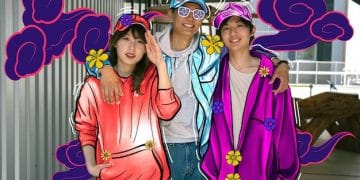Must-Watch: 3 New US Novel Dorama Adaptations Coming in 2025

Must-Watch: 3 New Dorama Adaptations of Popular US Novels Coming in 2025 promises a thrilling blend of beloved American stories reimagined through the captivating lens of Japanese drama, offering fresh perspectives and cultural nuances that are sure to enthrall audiences.
Get ready for a wave of exciting new doramas! In 2025, some of your favorite US novels are getting the dorama treatment, promising fresh takes and captivating storylines. Here’s a sneak peek at three Must-Watch: 3 New Dorama Adaptations of Popular US Novels Coming in 2025.
The Dorama Craze: Why Adapt US Novels?
The world of doramas is constantly evolving, seeking new and exciting stories to tell. Adapting popular US novels offers a unique opportunity to tap into a pre-existing fanbase while injecting fresh cultural perspectives and storytelling techniques. This trend has seen a surge in recent years, with studios eager to bring these beloved narratives to a wider, global audience. The appeal lies in the familiar storylines, coupled with the distinct charm and aesthetic of Japanese drama production.
The Allure of Cross-Cultural Storytelling
Dorama adaptations of US novels present a fascinating intersection of cultures. By reimagining American narratives through a Japanese lens, these adaptations offer a unique and often surprising perspective on familiar themes and characters. This cross-cultural exchange not only enriches the viewing experience but also fosters a greater understanding and appreciation of different cultural values and viewpoints.
Benefits of Adapting Well-Known Stories
Adapting established novels provides several advantages. There’s already a built-in audience familiar with the story and characters, reducing the risk for production companies. The established plot lines provide a solid foundation upon which to build, allowing for creative adaptations and reinterpretations. Furthermore, these adaptations can introduce a new audience to both the original novels and the world of doramas.
- Expands the reach of both the dorama and the novel.
- Offers a fresh perspective on beloved stories.
- Attracts a diverse audience with varied interests.
- Provides a stable framework for creative adaptation.
Ultimately, the trend of adapting US novels into doramas represents a compelling evolution in the entertainment industry, offering a exciting blend of familiar stories and fresh perspectives for viewers worldwide. The cross-cultural appeal and the advantages of adapting well-known narratives make it a promising trend to watch in the coming years.
“The Silent Patient” as a Psychological Thriller Dorama
“The Silent Patient,” Alex Michaelides’s gripping psychological thriller, is reportedly set to be adapted into a dorama filled with suspense and intrigue. This novel, known for its twisty plot and unreliable narrator, is ripe for a compelling on-screen adaptation, promising to keep viewers on the edge of their seats.
Casting and Character Interpretations
One of the most anticipated aspects of this adaptation is the casting. Who will portray the enigmatic Alicia Berenson and the determined Theo Faber? The actors chosen will need to capture the complex emotional landscapes of these characters, bringing a nuanced depth to their performances. The dorama is likely to explore the subtle cues and unspoken tensions between the characters to reveal the truth of the storyline.
Key Scenes and Plot Twists
The dorama adaptation will undoubtedly highlight some of the novel’s most memorable scenes. The shocking act of Alicia’s silence, Theo’s relentless investigation, and the climactic revelation of the truth will be crucial moments to translate effectively onto the screen. The adaptation will also aim to amplify the element of surprise through visual and storytelling techniques, providing a compelling and satisfying narrative arc.
- Alicia’s sudden silence after a violent act.
- Theo’s deepening obsession with her case.
- The unraveling of hidden truths within Alicia’s past.
- A shocking conclusion that redefines the story.
Overall, the dorama adaptation of “The Silent Patient” holds immense potential to captivate audiences with its intriguing plot, complex characters, and suspenseful atmosphere. The creative adaptation will surely highlight the novel’s strengths while offering a fresh and unique viewing experience.
“Little Fires Everywhere” Reimagined in a Japanese Setting
Celeste Ng’s “Little Fires Everywhere,” a novel exploring themes of class, race, and motherhood, is another exciting title rumored to be receiving a dorama adaptation. Set in a seemingly perfect suburban community, the story delves into the tensions that arise when secrets and differences come to light. Reimagining this story in a Japanese context would add a fascinating layer of cultural complexity.
Cultural Adaptations and Modern Themes
Adapting “Little Fires Everywhere” to a Japanese setting offers an opportunity to explore similar themes through a different cultural lens. The dynamics of social class, family expectations, and the roles of women in society could be interpreted in ways that resonate with Japanese audiences. The adaptation will also need to carefully consider the nuances of race and identity within the Japanese context, providing a thoughtful and relevant commentary on modern society.
The Role of Community and Family
The themes of community and family are central to “Little Fires Everywhere,” and these elements are particularly significant in Japanese culture. The dorama adaptation will likely emphasize the importance of harmony and belonging, while also exploring the challenges that arise when individual desires clash with societal expectations. The intricate relationships between the characters and their connections to the community will be key to the narrative.
- The emphasis on community harmony in Japan.
- The expectations placed on women in traditional and modern families.
- The impact of class differences on interpersonal relationships.
- The struggle to balance individual expression with societal norms.
The dorama adaptation of “Little Fires Everywhere” has the opportunity to create a thoughtful narrative that examines the intricate web of social connections, family values, and personal identities in a contemporary Japanese context. The cultural adaptations can offer new insights into the overarching themes, creating a unique and engaging viewing experience.
“Gone Girl” as a High-Stakes Japanese Drama
Gillian Flynn’s “Gone Girl,” a dark and twisted psychological thriller, is reportedly being considered for a dorama adaptation. This story, known for its shocking twists, unreliable characters, and exploration of marital deception, would make for a gripping and suspenseful Japanese drama.
Adapting the Thrilling Narrative for Japanese Television
One of the key challenges in adapting “Gone Girl” for Japanese television will be maintaining the intensity and suspense of the original narrative. The dorama adaptation will need to capture the unsettling atmosphere and the complex dynamic between Nick and Amy. The story’s intricate plot twists and psychological manipulations will require careful pacing and visual storytelling techniques to keep viewers engaged.
Exploring Themes of Deception and Relationships
“Gone Girl” delves deep into the themes of deception, manipulation, and the complexities of modern relationships. The dorama adaptation can use these themes to explore the cultural nuances of marriage and partnership in Japan. The adaptation may shed light on societal pressures, gender roles, and the hidden expectations that can undermine even the most seemingly perfect relationships.
- The exploration of marital expectations in Japan.
- The depiction of gender roles and societal pressures.
- The unmasking of hidden agendas and deceits.
- The examination of the dark side of relationships.
In conclusion, the dorama adaptation of “Gone Girl” presents an opportunity to create a captivating and thought-provoking series that explores the darker aspects of human relationships. The creative adaptation will need to balance the thrilling narrative with a nuanced understanding of the cultural context, resulting in a unique and memorable viewing experience.
Potential Challenges and Opportunities
Adapting US novels into doramas is not without its challenges. Cultural differences, language barriers, and varying audience expectations all need to be carefully considered. However, these challenges also present opportunities for creative problem-solving and innovative storytelling. By embracing the unique aspects of both cultures, dorama adaptations can create something truly special and engaging.
Navigating Cultural Differences
One of the biggest hurdles is bridging the gap between American and Japanese cultures. What works well in an American novel might not resonate with a Japanese audience, and vice versa. Adaptations must therefore be sensitive to cultural norms and values, while also staying true to the core themes and messages of the original story. This delicate balance requires careful consideration and creative adjustments.
Meeting Audience Expectations
Dorama fans have certain expectations when it comes to storytelling style, pacing, and character development. Adaptations need to be mindful of these expectations while also bringing something new and fresh to the table. By incorporating familiar dorama tropes while adding unique twists and turns, adaptations can satisfy existing fans and attract new viewers.
- Understanding the nuances of Japanese storytelling traditions.
- Balancing faithfulness to the source material with creative adaptations.
- Engaging both existing dorama fans and new audiences.
- Addressing potential cultural misunderstandings or misinterpretations.
Ultimately, the success of these dorama adaptations hinges on their ability to navigate these challenges and capitalize on the opportunities they present. By embracing the cross-cultural potential and incorporating creative storytelling techniques, these adaptations can carve out a unique space in the world of entertainment and capture the hearts of viewers worldwide.
The Future of US Novel Dorama Adaptations
The trend of adapting US novels into doramas appears poised to continue, with more and more studios recognizing the potential of this cross-cultural exchange. As technology continues to connect the world, expect to see even greater collaboration and innovation in the realm of international storytelling. The future is bright for those who seek to blend the best of both worlds, creating stories that resonate with audiences across borders.
The Rise of Global Storytelling
The entertainment industry is becoming increasingly globalized, with content from different regions finding audiences around the world. Dorama adaptations of US novels are a prime example of this trend, demonstrating the power of storytelling to transcend cultural boundaries. As audiences become more open to diverse narratives, expect to see even more collaborations and adaptations in the years to come.
Continued Innovation and Collaboration
The success of future dorama adaptations will depend on continued innovation and collaboration between creators from different backgrounds. By working together and learning from each other, they can create stories that are both authentic and universally appealing. The key is to embrace the differences and find common ground, resulting in narratives that resonate with viewers from all walks of life.
- Increased collaboration between US and Japanese studios.
- Greater emphasis on cultural sensitivity and accuracy.
- More innovative storytelling techniques and visual effects.
- Wider distribution and accessibility to global audiences.
In summary, the future of US novel dorama adaptations is filled with immense potential and possibilities. By embracing the challenges, capitalizing on the opportunities, and fostering collaboration, the entertainment industry can reach new heights of creativity and captivate audiences worldwide.
| Key Point | Brief Description |
|---|---|
| 🎬 Dorama Adaptations | US novels adapted into Japanese doramas are coming. |
| 📚 “The Silent Patient” | Alex Michaelides’ thriller adapted into a suspenseful dorama. |
| 🔥 “Little Fires Everywhere” | Celeste Ng’s novel reimagined in a Japanese setting with cultural themes. |
| 💔 “Gone Girl” | Gillian Flynn’s dark thriller is considered for a Japanese dorama adaptation. |
Frequently Asked Questions
▼
Adapting US novels offers a fresh perspective on familiar stories, attracting a diverse audience by blending American narratives and Japanese storytelling techniques.
▼
The adaptation will focus on the characters’ emotional depths and key suspenseful scenes, bringing a nuanced depth to the performances and unexpected plot twists.
▼
The dorama will explore themes of social class, family expectations, and women’s roles in Japanese society, offering a unique cultural lens on the original story.
▼
The dorama may shed light on societal pressures and gender roles within Japanese marriage, revealing hidden expectations that can undermine relationships.
▼
Adapting US novels into doramas faces challenges such as bridging cultural differences and meeting dorama fan expectations, requiring creative adjustments.
Conclusion
The upcoming dorama adaptations of popular US novels promise captivating storytelling, blending familiar narratives with unique Japanese perspectives. By exploring themes of suspense, cultural adaptation, and relationship complexities, these doramas are poised to captivate audiences and offer fresh interpretations of beloved stories.





